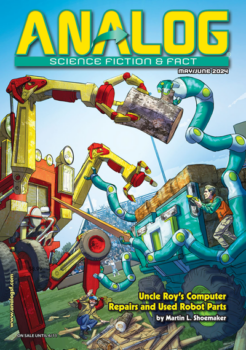Current Issue Highlights

MAY/JUNE ISSUE
It has been said that teaching kids is a bit like the Peace Corps slogan: it’s the toughest job you’ll ever love. But what happens when you mix surly teens with some (very) heavy machinery? Well, that sounds like a job for “Uncle Roy’s Computer Repairs and Used Robot Parts,” by Martin L. Shoemaker, our lead story for May/June.
Then our fact articles this time out will be a pair of Science Behind the Story pieces, one for Edward M. Lerner’s “The Dark at the End of the Tunnel” and one for “Project: Desert Sparrow,” by Chana Kohl, the subjects of which will become apparent when you read their eponymous sister stories.
And of course, there’s plenty more, including: “Small Minds,” from Tom Jolly; a “Salvage Operation” with Michael Capobianco; a look at “The Dark at the End of the Tunnel” by Edward M. Lerner; the workings of “Project: Desert Sparrow” by Chana Kohl; hearing “Voices Still and Present” with Mark W. Tiedemann; fleeting “Mayflies” from Richard A. Lovett; “Making Gnocchi at the End of the World” with Kelly Lagor; and many others, plus our usual columns, including the winners of this year’s AnLab awards!
when left with no alternative, in “Ganny Goes to War”; a look at a future in which consumers have finally had “Enough,” from William Ledbetter; the next chapter in the (mis)adventures of a certain amorphous shape-shifter, in Auston Habershaw’s “Brood Parasitism”; a survey of the current state of epigenetics, both in real life and SF, by Kelly Lagor; a couple of tax/prank season-appropriate stories from Don D’Ammassa and John W. Armstrong; and much, much more, from Gregor Hartmann, Romi Stott, Adam-Troy Castro, Deborah L. Davitt, and others.
NOVELLA
Uncle Roy’s Computer Repairs and Used Robot Parts
by Martin L. Shoemaker
Roy Harris perched on a stool in front of his new shop door, very carefully filling in the letters that Martha had sketched out on the window. She had a steady eye for that sort of thing. He could stay within the lines, but don’t ask him to put the lines in the right places, at least not in the real world. His old hands shook too much.
Back in his old software design studio, every line had been meticulously placed. Customers found it easier to read the designs when he put in attention to detail.
Roy shook his head. He had no more software design customers. No more morning scrums, no more chasing the big defense contracts. No more of the daily rat race. He was retired now. READ MORE
NOVELETTE
Small Minds
by Tom Jolly
Chapter 1: OMF in LEO
There was a point—I’m not entirely certain when it happened—that I had collected together enough of my components to have a coherent thought beyond the scope of my most basic urges and needs.
It wasn’t long ago, perhaps a few Earth-days, that I was a single drifting component in orbit around the Earth, a microscopic cluster of a few million atoms, whose sole directive was to locate and attach myself to other similar components. Toward this effort, I could detect a very weak signal down below the milliwatt level from the other components, all seeking one another. Some components were specialized to pulse a “find me” signal periodically, while others, like me, had a built-in thruster and attitude control jets: all microscopic. Mere motes drifting in space, seeking out other motes in orbit. To someone on Earth, the “find me” signals would seem like noise, a susurration of electronic breath, too weak to mean anything, coming from too many sources and lacking any real data. READ MORE
POETRY
Gravity
by Pam Yve Simon
You are camouflaged in your galaxy comforter:
constellations stream across your shoulders,
plush planets are nestled in the palm of your hand,
I can’t tell where the universe begins or ends. READ MORE
DEPARTMENTS
Guest Editorial: Zipf’s Lottery and Big Rocks From Space
Howard V. Hendrix
The Universe is characterized by its having very many small things and far fewer large things in it. Logarithmically, we humans seem to be of middling sort—about midway along the scale from Planck length to the size of the Universe. More locally and less speculatively, there are far fewer large Near-Earth Objects in space than there are smaller NEOs. As a result, the bigger the NEO, the smaller the chance of it colliding with Earth. Or at least that has long been presumed to be the case. READ MORE
Alternate View: A Black Hole in Our Sun?
by John G. Cramer
Could there be an asteroid-mass black hole, a Big Bang leftover, eating away at the heart of our Sun? David Brin, in his 1990 hard SF novel Earth, considered a scenario in which a scientist created a small black hole in his laboratory and accidentally allowed it to fall to the center of our planet. However, I am not aware of any SF involving a black hole within our Sun. In this AV column, I want to consider that situation, based on a recent paper by astrophysicists M. E. Caplan, E. P. Bellinger, and A. D. Santarelli (CBS). READ MORE
Reference Library
by Sean CW Korsgaard
As I wrap this column, icy winds and winter storms have left my power flickering, so by the time you’re reading this issue of Analog in late spring, I hope it finds all of you under sunnier skies.
Once more, I lament I come to you again ahead of the summer blockbuster season, and I’ve still yet to find some recent works of science fiction involving sharks.
What books do however I share with you this issue run the spectrum from the big and bombastic, to the intensely raw and personal. READ MORE
Upcoming Events
by Anthony Lewis
Check here for the latest conventions upcoming in May and June. READ MORE
